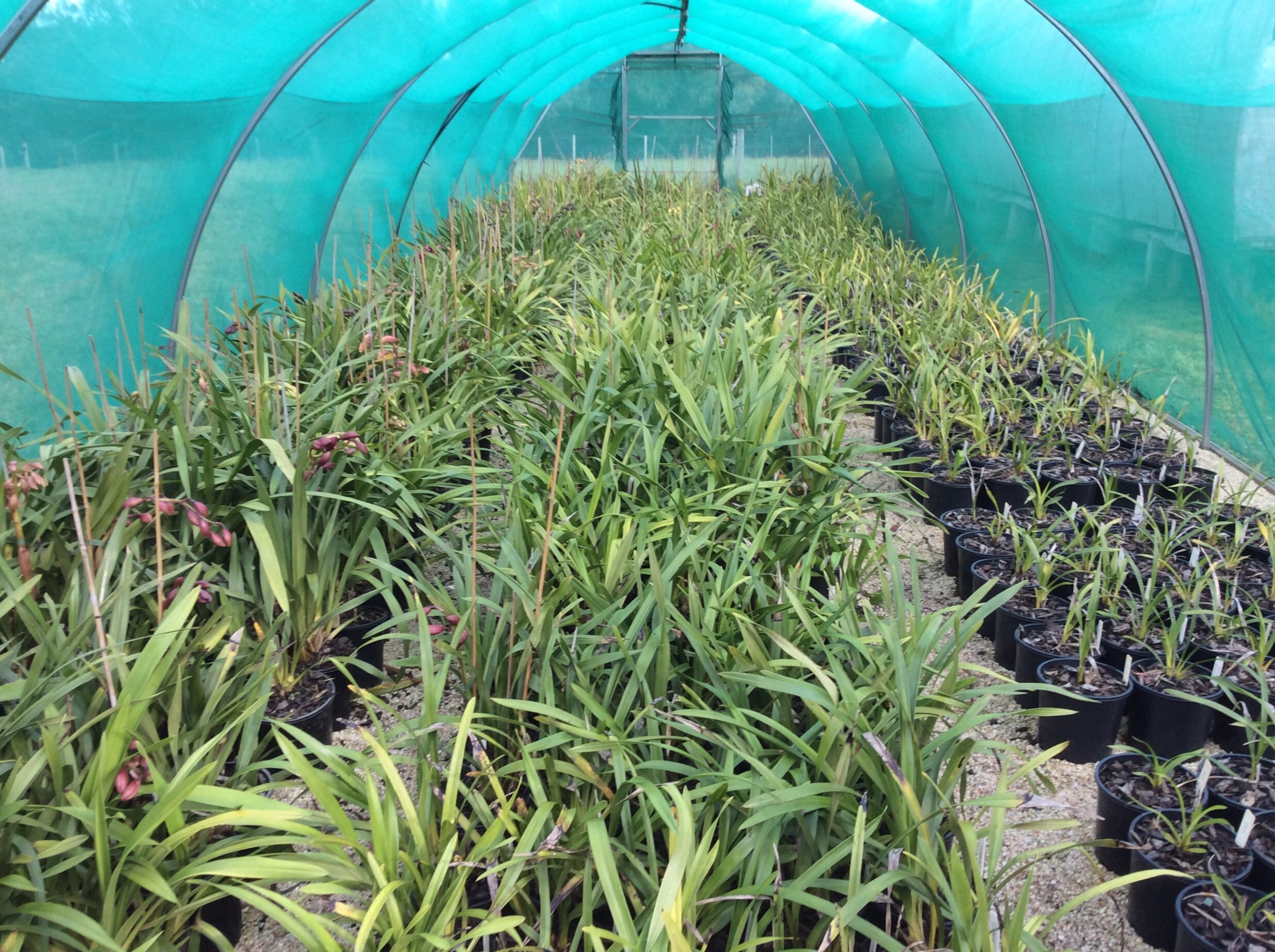
Light
Cymbidiums are best grown under 50% shade, either in a shade house, under a tree with filtered light, or on a verander facing East for the morning sun and afternoon shade.
Unless you have a shade house with orchid benches, Cymbidiums are best grown on plastic saucers filled with either the mix they are grown in, or 7mm river pebbles.
Water
During the flowering season they can be grown indoors with fresh air once a week when they are watered, until the water runs out of the pot onto the saucer.
During the remainder of the year, excluding Winter, simply water your orchid when the mix or pebbles dry out.
During Winter check weekly to ensure the saucer is not full of water. Drain water if required.


Fertilizer & Temperature
The key to growing Cymbidiums is fertilizing them fortnightly with a recommended orchid fertilizer. Remember a healthy plant will produce strong spikes and great flowers.
The key to flowering Cymbidiums is to ensure they have a 6c drop in temperature during Dec Jan Feb, to force them into spike and the best way to do this, is to change your watering from morning to evening during this period.
Flowering Orchid arrives home
Suggest keep the orchid inside on a plastic saucer containing orchid mix, without it sitting in water. Take outside to water weekly until it runs out the bottom of the pot, don’t wet the flowers. Once it drains return to the saucer inside to enjoy the flowers.
Don’t let the flowers die on the plant, to ensure the plant puts all of its energy into growing a new bulb for next years flowers. Cut the spike off at the base of the stem with a 45 degree cut 4 weeks after the last flower opens. Flowers will last another 3-4 weeks in a vase, if you cut 1-2cm off the stem once a week when you change the water.
Ongoing suggest buy Strike Back pellets from Bunnings; sprinkle around the plant on the bark, so the plant is fertilized ever time it is watered. When you can’t see the pellets sprinkle again. Continue fertilizer through the growing months from Spring to the end of Autumn, or util flowers have opened for plants that have produced a new spike.


Repotting
The best time to repot is after flowering, or every 2 years in October to refresh the plant mix. Suggest buy Orchiata Bark from Bunnings.
Remove the orchid from its pot, untangle the roots and carefully remove old backbulbs with dead roots. Using the same pot, hold the plant in the middle of the pot with one hand, ensuring the base of the bulbs are level with the top of the pot. Add Orchiata bark with your other hand. When full press the bark down into the roots with your fingers so that the plant is supported. Add more bark to top up the pot. Water until it runs out the bottom of the pot. Begin fertilzer program the following week.
Calendar
We use the following year calendar for our monthly activity, based on Orchids Month by Month by Ralph Handcock and Margaret Smith, which has proven to be a great guide for growing and flowering Cymbidiums. Your growing conditions may require an adjustment.
When you arrive home with your new orchid in flower, enjoy the flowering period inside by standing the pot on a black plastic saucer filled with orchid pine bark, keeping the water level just below the bark, on a bench or inside a decorative pot. Orchid pine bark is available from Bunnings. While there pick up some Strike Back pellets and sprinkle a few around the plant, so that it gets fertilized when you water weekly.
To give your orchids a better chance of flowering next year, remove the flower spike from the plant 4 weeks after the last bud opens and keep them in a vase. Change the water weekly and trim apx 2cm with a diagonal cut from the bottom of the spike, to ensure the water reaches the flowers.


Growing Season
Nov
Morning watering every 2nd day, daily if +30c. Fertilize with Strike Back pellets if required.
Dec
Change watering to Evening every 2nd day, daily if +30c. Fertilize with Strike Back pellets if required.
Jan
Evening watering every 2nd day, daily if +30c. Black leaf tips too much water, brown leaf tips not enough. Fertilize with Strike Back pellets if required.
Feb
Evening watering every 2nd day, daily if +30c. Watch for red spider, thrips, scale, leaf fungus. Spray with Mancozeb and/or White Oil. Fertilize with Strike Back pellets if required.
Spike Season
Mar
Change watering to am every 2nd day. Watch for snails as spikes develop. Second best time to repot. Fertilize with Strike Back pellets if required.
Apr
Water am every 3rd day. Train spikes on stakes. Cover plants to protect flowers from rain. Fertilize with Strike Back pellets if required.
May
Water am every 4th day. Train spikes. Fertilize with Strike Back pellets if required.
Jun
Water am once a week. Train spikes. Finish Fertilizer program for non flowering plants, otherwise Fertilize with Strike Back pellets if required.


Flowering Season
Jul
Water flowering plants am ever 3rd day, non-flowering plants weekly. Watch for aphid on buds, scale, rust. Spray with Mancozeb and/or White Oil. Fertilize flowering plants with Strike Back pellets if required.
Aug
Water flowering plants am ever 3rd day, non-flowering every 3rd day. Fertilize flowering plants with Strike Back pellets if required.
Sep
Water flowering plants am every 3rd day, non-flowering plants every 3rd day. Fertilize flowering plants with Strike Back pellets if required.
Oct
Water flowering plants am every 3rd day, non-flowering plants every 2nd day. Repot plants that have flowered. Fertilize with Strike Back pellets.
